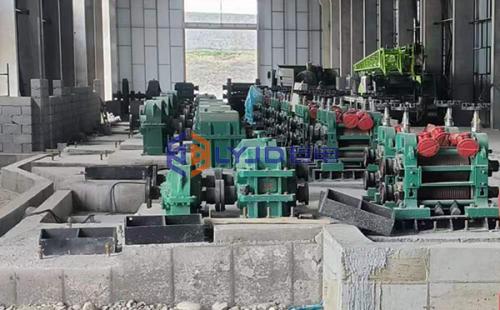What Steel Mill Equipment Do You Need to Build a Rebar Production Line?

We always see a splendid steel mill and are surprised by the equipment, which we even don’t know. Then, what steel mill equipment do you need to build a rebar production line? Please see below.
Induction Melting Furnace: An induction melting furnace is a type of furnace used for melting metals using electromagnetic induction. It is commonly employed in steel mills, foundries, and other metalworking industries for melting various types of metals, including steel, iron, copper, aluminum, and their alloys. It's important to note that the size, capacity, and specific features of induction melting furnaces can vary depending on the intended application and the type of metal being melted. The furnace design may differ for small-scale operations and large industrial melting processes.
Continuous Casting Machine: This machine is responsible for the solidification of the liquid steel into continuous billets or blooms. It typically comprises a tundish, a water-cooled copper mold, and a series of rollers or oscillators. The liquid steel is poured from the EAF into the tundish and then flows through the copper mold, where it solidifies into a continuous strand. The rollers or oscillators guide the strand and control its dimensions.
Reheating Furnace: The reheating furnace is used to raise the temperature of the billets or blooms before they enter the rolling mill. It ensures that the steel is malleable and can be efficiently rolled. Reheating furnaces can use various fuel sources, such as natural gas, coal, or electricity, to generate the necessary heat. The furnace may have a walking beam, pusher, or rotary hearth design to transport and heat the steel.
Rolling Mill: The rolling mill is a crucial component of the rebar production line. It receives the continuous billets or blooms from the continuous casting machine and processes them to form the final rebar product. The rolling mill consists of multiple stands, each containing a set of rolls. The rolls apply pressure to the steel, gradually reducing its cross-sectional area and shaping it into the desired profile. The rebar is typically rolled in a series of passes to achieve the desired dimensions and mechanical properties.
Descaling Equipment: Descaling is an important step to remove scale, oxides, and other impurities from the surface of the steel before rolling. Descaling can be done using high-pressure water jets that spray water onto the steel or mechanical descalers that employ rotating brushes or abrasive materials to remove the scale. This process improves the surface quality of the rebar and prevents defects during rolling.
Cooling Bed: The cooling bed is a long table equipped with cooling elements, such as fans or water sprays, where the freshly rolled rebar is placed to cool and stabilize. The cooling bed allows the rebar to gradually reduce its temperature, preventing excessive heat retention and ensuring proper metallurgical properties. The cooling bed may also have automated systems to align, bundle, and transfer the cooled rebar for further processing or packaging.
Cutting and Bending Machines: Once the rebar has been rolled to the desired length, cutting and bending machines are employed to produce rebar in specific sizes and shapes. Cutting machines use shearing or abrasive methods to cut the rebar to the required lengths. Bending machines utilize hydraulic or mechanical forces to bend the rebar into various angles, curves, or stirrups, as specified by the customer or project requirements.
Finishing Equipment: Finishing equipment is used to ensure the quality and consistency of the rebar. This equipment may include straightening machines to remove any residual bends or twists, surface inspection systems to detect surface defects or discontinuities, and quality control tools to measure dimensional accuracy, hardness, and other properties. Finishing equipment plays a crucial role in meeting the required standards and specifications for the rebar.
Packaging and Labeling Machines: Once the rebar has undergone finishing processes and quality checks, it is typically bundled and packaged for transportation. Packaging machines are used to bundle the rebar into specific quantities, often secured with binding wire or straps. Labeling machines can apply tags or labels that provide information such as rebar size, grade, heat number, and other relevant details for identification and traceability purposes.
Handling Equipment: Various types of handling equipment, such as cranes, conveyors, and material handling systems, are essential for the efficient movement of raw materials, semi-finished products, and finished rebar within the production line. Cranes are commonly used for lifting and transferring heavy loads, while conveyors facilitate the movement of steel between different stages of the production process. Material handling systems ensure smooth and organized material flow, enhancing productivity and safety.
These are the key equipment components involved in building a rebar production line. Each piece of equipment serves a specific purpose in transforming scrap metal into finished rebar products. The configuration and specifications of the equipment may vary depending on the production capacity, desired rebar sizes and grades, and the technological advancements adopted by the steel mill.
Post Your Ad Here



Comments